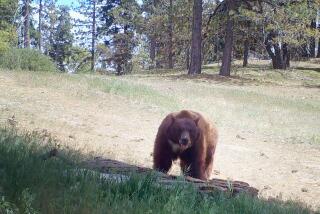Teaching an Australian marsupial to choose life
Ever since its arrival in Australia, the poisonous cane toad has been killing native predators such as the northern quoll, a cat-sized marsupial.
Now scientists have found a clever way to save the endangered quoll: training it to detest the taste of toad so it won’t get poisoned.
Brought to Queensland state in 1935 to control beetles in sugar cane fields, the cane toad is one of many Old World animals to wreak havoc on Australia’s native ecosystem.
Unlike most invasive species, however, the cane toad doesn’t prey on native life, or compete with it for food. Instead, this toxic toad poisons the large predators -- such as quolls, crocodiles, snakes and lizards -- that dine on it.
Should a predator survive to eat another meal, it will think twice about dining on cane toad, said study coauthor Richard Shine, an ecologist at the University of Sydney.
But because the toads are large, the quolls -- which are notorious for gobbling anything from small bugs to mammals nearly as big as they are -- usually have no chance to learn to avoid the toad.
To create an aversion to cane toad, Shine and researchers Jonathan Webb and Stephanie O’Donnell at the University of Sydney fed young quolls tiny cane toads laced with a nausea-inducing chemical generally used to deworm cattle and sheep.
The tiny dead toads, which weighed less than a tenth of an ounce, could not kill the quolls. But Webb, who came up with the idea for the experiment, speculated that the memory of the stomach-churning snack would stick with the marsupials, just as bad experiences with food can stick with humans for years.
His theory panned out.
Scientists released 31 “toad-smart” quolls and 31 “toad-naive” quolls into the wild, fitted with radio collars designed to fall off within a month (though several animals died and others disappeared well before then).
Overall, the scientists found that the conditioned female quolls survived nearly twice as long as their unconditioned counterparts, and the conditioned male quolls lived five times longer than the clueless ones.
“Within hours of their release, we saw four toad-naive [male] quolls attacking large toads, then convulsing and dying,” the authors said in their report, which was published online Tuesday in the Journal of Applied Ecology.
“This is just really unusual,” said David Patte, assistant regional director of external affairs for the U.S. Fish and Wildlife Service out of Portland, Ore., who was not involved in the research. Patte said he had not encountered a case in which endangered animals had been conditioned to modify their behavior to aid in their own survival.
“We need as many innovative approaches as possible, so that’s great,” he said.
It’s unclear whether the aversion to cane toad will be passed on to the next generation, Shine said. His hope is that the no-toad diet will be easily picked up by baby quolls.
Having proved the concept in the lab, Shine said, the next step is to devise an effective way to teach wild quolls -- perhaps by air-dropping nausea-inducing sausages of cane toad meat into what little toad-free territory remains in the quoll’s habitat. Eating the sausages would help teach the quolls to avoid the toads before the amphibians move in and become a problem.
The scientists also hope to use the behavior-modification techniques to train crocodiles and other large predators at risk from the cane toad.
More to Read
Start your day right
Sign up for Essential California for news, features and recommendations from the L.A. Times and beyond in your inbox six days a week.
You may occasionally receive promotional content from the Los Angeles Times.







